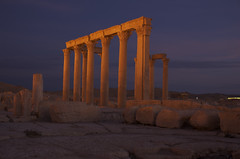A sizable portion of Monday morning's flights into Heathrow had been canceled. There was no traffic from France at all, and Holland was suffering as well. My Swiss service was waved through, but only just. The pilot took a nap when we started our descent and let the machines take over. Ten minutes later, an automatic landing brought the plane down on British soil, more smoothly than most experienced operators. It was impossible to tell where we were. The world was greyed out.
I was delighted. My arrival couldn't have been timed any better. For my first journey back to the UK, nine months after closing a door on a stay of more than seven years, I got the weather that the country is infamous for the world over – weather that, coincidentally, I experienced only very infrequently while living in London. It has been mentioned before in these pages that London's reputation for thick fog rests of coal-fired furnaces whose soot helped condense the moisture in the air.
Through the ages up to the fifties, fog was all the rage. There was no winter without, and maybe not even a month, consistency that shaped opinions globally. This changed only with the passing of the Clean Air Act in 1956. Heating switched to electricity or gas, the use of coal was discontinued, and the fog disappeared. The weather remained dismal, but global warming changed that as well. Over the last two decades or so, London has shifted south climatically, to the pleasure of Londoners in general and the wine growers in Surrey, Sussex and Kent in particular. The south of England is now sunny, clear and mild.
On Monday morning, it looked quite different. The sun was nowhere to be seen and neither was the sky. Whether there was much fog on the ground on the drive west from the airport was actively debated. I saw the motorway ahead just fine and nothing left and right, but there isn't anything of note left or right anyway. When Slough and Reading are announced, it's best to focus on the road and let them pass like minor nuisances. Still, some drivers were confused and switched their fog lights on, blinding traffic behind. I turned my high beams on to fight back, and shot towards Diamond for meetings.
When you live in London, everything outside the M25 (an easy topographical boundary) or out of reach by the Underground doesn't really exist – with the possible exception of Brighton for a day by the beach. The passionate debate about Scottish independence didn't reach haughty Londoners for whom the only independence worth debating is the independence of the city. Let the rest be all Scotland.
My stay this week put me in the opposite position. I didn't get closer to London than the M25, on which I quarter-orbited in a little plastic Fiat. Nevertheless, it was a trip filled with memories. Diamond, already mentioned a few paragraphs up, is where I spent many nights collecting diffraction data on the crystals that popped up left and right during the tail end of my tenure at Imperial.
Cambridge was the other destination of this trip, another place I've visited a few times, most recently after I had taken over the X-ray facility at Imperial and needed to scout good operating practices. This time, I revisited one of the institutes I had seen back then, but the most vivid memories didn't relate to that. They arose in the hotel, which was as English as my flat had been. In the bathroom, the floor was warped, a cord dangling from the ceiling switched on the lights, and the loo wouldn't flush the poo. The only disappointment was the faucet, which was able to mix hot and cold water instead of dispensing it separately, as is tradition.
Getting to Cambridge could have been a pleasant hour on the train, had the line between Oxford and Cambridge not been axed in 1967 by car-centric modernizers with rather foggy vision. Instead, it was a painful two-hour drive through almost Californian traffic. Throughout, I never caught a glimpse of London. Just as the rest of the country is invisible to Londoners, London was invisible to me. The fog had little to do with this. For the most part, the M25 runs in a wide trench that cannot possibly be natural but would be a mightily impressive civil engineering project if it weren't. Does London still exist? It will take another trip to tell.

No comments:
Post a Comment